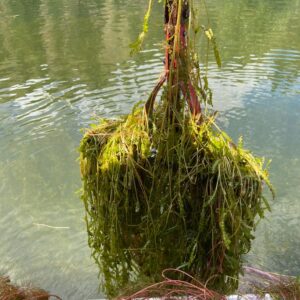Aquatic Weeds
Aquatic plant management: aquatic “weeds”
What are aquatic weeds?
“Aquatic weeds,” “lake weeds,” and “water weeds” are catch-all terms for aquatic plants, algae, and sometimes blue green algae. This includes both native and invasive water plants, wanted or not. While most lake users accept a certain level of aquatic plant growth, these lake plants may become lake weeds with more growth. An internet search for “weeds in my lake” returns many services to kill lake weeds or for lake weed removal. However, more information is needed to determine how these aquatic plants or aquatic weeds should be controlled.
Aquatic plants are important. Water plants (and water weeds) make oxygen from photosynthesis, are a major food source for fish and other wildlife in the lake, help stabilize soil, and help prevent shoreline erosion. Many lake plants are considered beneficial (native Chara algae, some pondweeds, duckweed, and native water lily) or neutral (native watermilfoil, coontail, waterweed), while others are a nuisance or invasive (e.g., curly leaf pondweed, Eurasian watermilfoil, starry stonewort). For example, floating plants like water lilies are sometimes a nuisance and treated with herbicide – yet they provide a home to small game fish such as northern pike. Knowing what lake plants or river plants are in the patch of “water weeds” will help show if lake management action is needed and which aquatic weed control strategies will actually work.
 Can they be controlled?
Can they be controlled?
An aquatic plant survey (as part of an aquatic plant management plan) will enable people to know more about the water plants or water weeds in their lake. That is, where and what native aquatic plants are growing, what invasive aquatic plants and native aquatic weeds are growing, and where there is a mix of native and invasive water plants. This, in turn, will allow better lake weed control efforts that reduce impacts to beneficial lake plants and other wildlife. This also helps the treatment effectiveness and cost savings.
Although lake weed control strategies have improved, current practices can only bring weeds to lower levels and often need yearly work or repeated treatments. Few are able to completely solve a water weed problem. While aquatic herbicide or algaecide treatment is common for nuisance pond weeds, integrated control strategies (e.g., that combine chemical, mechanical/physical, and/or biological methods) can be better than a single strategy. In addition, the lake weed problem may be external, such as a leaking septic tank or other source of nutrient pollution. Doing an aquatic plant survey for a lake management plan may lead to a reduced aquatic weed problem by finding these potential issues. This is why it is important to take a broad look at the problem before spraying (or hiring someone to spray) aquatic herbicide and algacide. In addition, in many states aquatic herbicides and algaecides require a permit.
Where do I find out more?
Many lakes have issues with aquatic plants. This varies by lake based on factors like nutrients, temperature, and lake use. If your lake has nuisance aquatic plant levels, contact a lake management service to help decide if lake weed control efforts are needed. (see the “Management Plan” fact sheet for info on finding a lake management service provider). The state’s natural resource agency is also a good resource for advice on aquatic plants.
Factors that may impact whether control is attempted include: what plants do the aquatic weeds consist of (native or invasive)? How much of the lake has water weeds? Have the lake weed levels been staying about the same or increasing?